Brain States and Consciousness
2-14 What do we mean by consciousness, and how does selective attention direct our perceptions?


In the lively field of neuroscience, researchers are addressing many exciting questions. Among the most interesting are those in the subfield of cognitive neuroscience, in which people from many disciplines join forces to study connections between brain activity and mental processes, including states of consciousness.
Consciousness is our awareness of ourselves and our environment. It arises not from any one brain area but from the coordinated activity of the whole brain (Gaillard et al., 2009; Koch & Greenfield, 2007; Schurger et al., 2010). A telltale sign of conscious awareness appears in brain scans as a pattern of strong signals bouncing from one brain area to another (Boly et al., 2011).
Consciousness lets you assemble information from many sources as you reflect on the past, plan for the future, and focus on the present. You’ll encounter aspects of consciousness throughout this text. Conscious awareness forms one track of the dual-track mind, one of the four themes running through this text. In Chapter 5, we’ll consider hypnosis and its use to relieve pain. In Chapter 13, we’ll look closely at consciousness-altering drugs and their effects. Here we explore the role of attention and the altered states of consciousness we all experience—sleep and dreams.
51
Selective Attention
Through selective attention, your awareness focuses, like a flashlight beam, on a very limited aspect of all that you experience. Until reading this sentence, you have been unaware that your shoes are pressing against your feet or that your nose is in your line of vision. Now, suddenly, the spotlight shifts. Your feet feel encased, your nose stubbornly intrudes on the words before you. While focusing on these words, you’ve also been blocking other parts of your environment from awareness, though your peripheral vision would let you see them easily. You can change that. As you stare at the X below, notice what surrounds these sentences (the edges of the page, the desktop, the floor).
X
Talk on the phone or attend to a music player or GPS while driving, and your selective attention will shift back and forth between the road and its electronic competition. But when a demanding situation requires it, you’ll probably give the road your full attention. You’ll probably also blink less, as we do when focused on a task (Smilek et al., 2010). So why not use a cell phone while driving? Because we pay a toll for switching attentional gears, especially when we shift to complex tasks, like noticing and avoiding cars around us. The toll is a slight delay in coping (Rubenstein et al., 2001). In experiments that mimicked actual driving conditions, students talking on cell phones—either hand-held or hands-free—have been slower to detect and respond to traffic signals, billboards, and other cars (Horrey & Wickens, 2006; Strayer & Watson, 2012). Another study tracked long-haul truck drivers for 18 months. The video cameras mounted in their cabs showed they were at 23 times greater risk of a collision while texting (VTTI, 2009). Mindful of such findings, the United States in 2010 banned texting by truckers and bus drivers while driving (Halsey, 2010). Because our attention is selective—in one place at a time—multitasking comes at a cost. In 28 percent of all U.S. vehicle crashes, people were talking on cell phones or texting (National Safety Council, 2010).

We consciously process only a tiny sliver of the immense ocean of visual stimuli constantly before us. In one famous study, people watched a one-minute video of basketball players, three in black shirts and three in white shirts, tossing a ball (Becklen & Cervone, 1983; Neisser, 1979). Researchers told the viewers to press a key each time they saw a black-shirted player pass the ball. Most were so intent on the game that they failed to notice a young woman carrying an umbrella stroll across the screen midway through the clip. During a replay they were amazed to see her! Their attention focused elsewhere, the viewers suffered from inattentional blindness. Would a gorilla-suited assistant thumping his chest and moving through the swirl of players be more visible? No—half the pass-counting viewers failed to see him, too (Simons & Chabris, 1999).
In another follow-up experiment, only 1 in 4 students absorbed in a cell-phone conversation while crossing a campus square noticed a clown-suited unicyclist in their midst (Hyman et al., 2010). (Most of those not on the phone did notice.) (See Figure 2.25.)
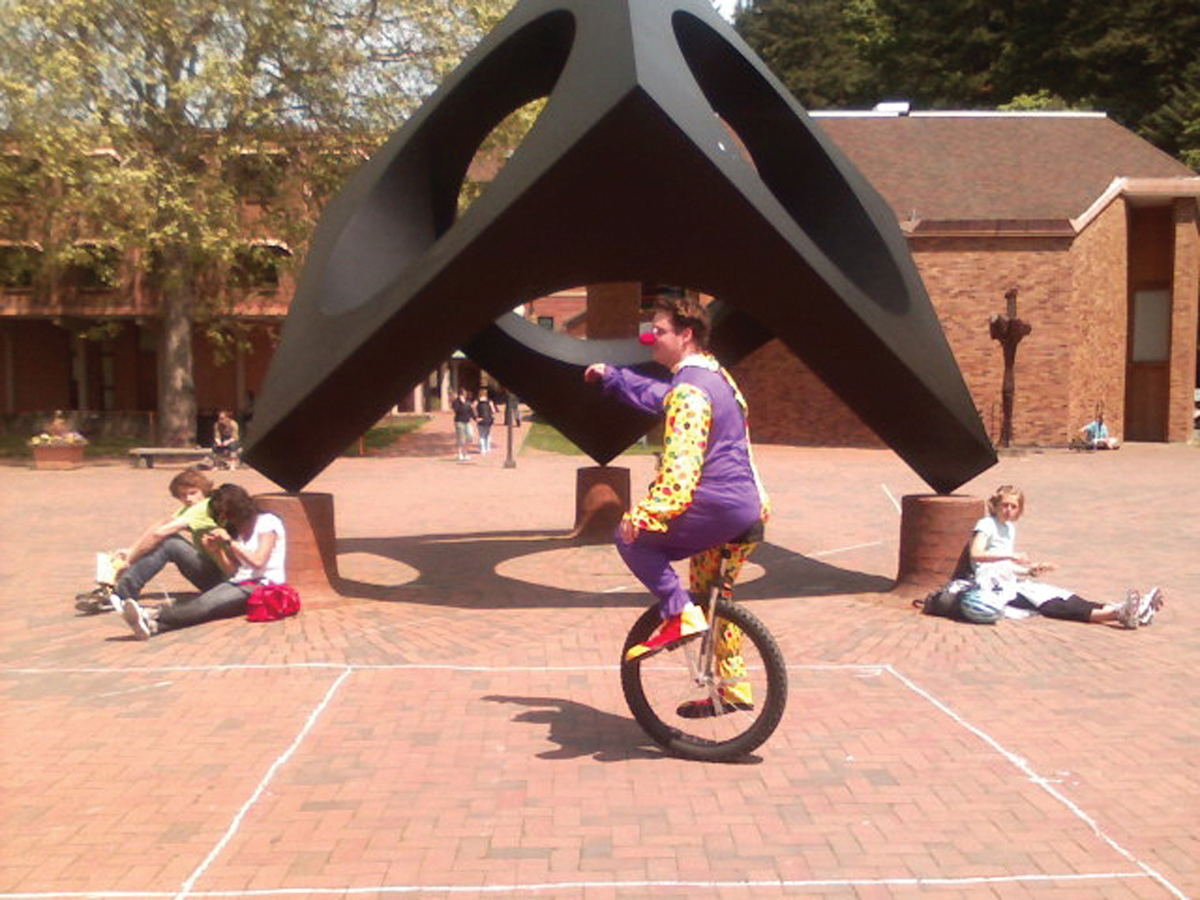
Given that most of us miss people strolling by in gorilla and clown suits while our attention is focused elsewhere, imagine the fun that magicians can have by distracting us. Misdirect our attention and we will miss the hand slipping into the pocket. “Every time you perform a magic trick, you’re engaging in experimental psychology,” says magician Teller, a master of mind-messing methods (2009).
Magicians also exploit our change blindness. By selectively riveting our attention on their left hand’s dramatic act, we fail to notice changes made with their other hand. In laboratory experiments, viewers didn’t notice that, after a brief visual interruption, a big Coke bottle had disappeared, a railing had risen, or clothing color had changed (Chabris & Simons, 2010; Resnick et al., 1997). Figure 2.26 shows a drawing imitating the idea behind one study in which two-thirds of the people giving directions to a construction worker failed to notice when he was replaced by another worker. Out of sight, out of mind.

52
The point to remember: Attention is powerfully selective. Our conscious mind is in one place at a time. But outside our conscious awareness, the other track of our two-track mind remains active—even during sleep, as we see next. 
RETRIEVE + REMEMBER
Question 2.19
Explain three attentional principles that magicians may use to fool us.
Our selective attention allows us to focus on only a limited portion of our surroundings. Inattentional blindness explains why we don’t perceive some things when we are distracted by others. And change blindness happens when we fail to notice a relatively unimportant change in our environment. All these principles help magicians fool us, as they direct our attention elsewhere to perform their tricks.
Sleep and Dreams
Now playing at an inner theater near you: the premiere showing of a sleeping person’s vivid dream. This never-before-seen mental movie features engaging characters wrapped in a plot that is original and unlikely, yet seemingly real.
Waking from a dream, we may wonder how our brain can so creatively, colorfully, and completely construct this inner-space world. Caught for a moment between our dreaming and waking consciousness, we may even be unsure which world is real.
“I love to sleep. Do you? Isn’t it great? It really is the best of both worlds. You get to be alive and unconscious.”
Comedian Rita Rudner, 1993
Sleep’s mysteries have puzzled scientists for centuries. Now, in laboratories around the world, some of these mysteries are being solved as people sleep, attached to recording devices, while others observe. By recording brain waves and muscle movements, and by watching and sometimes waking sleepers, researchers are glimpsing things that a thousand years of common sense never told us.
Biological Rhythms and Sleep
2-15 What is the circadian rhythm, and what are the stages of our nightly sleep cycle?
Like the ocean, life has its rhythmic tides. Let’s look more closely at two of these biological rhythms—our 24-hour biological clock and our 90-minute sleep cycle.
CIRCADIAN RHYTHM Try pulling an all-nighter, or working an occasional night shift. You will feel groggiest in the middle of the night but may gain new energy around the time you would normally wake up. Your body is reacting in part to its own wake-up call. The human body is kept roughly in tune with the 24-hour cycle of day and night by an internal biological clock called the circadian rhythm (from the Latin circa, “about,” and diem, “day”). As morning approaches, body temperature rises, then peaks during the day, dips for a time in early afternoon (when many people take naps), and begins to drop again in the evening. Thinking is sharpest and memory most accurate when we are at our daily peak in circadian arousal.
Age and experience can alter our circadian rhythm. After about age 20 (slightly earlier for women), we begin to shift from being evening-energized “owls” to being morning-loving “larks” (Roenneberg et al., 2004). Most college students are owls, with performance improving across the day (May & Hasher, 1998). Most older adults are larks, with performance declining as the day wears on. By mid-evening, when the night has hardly begun for many young adults, most retirement homes are quiet.
53
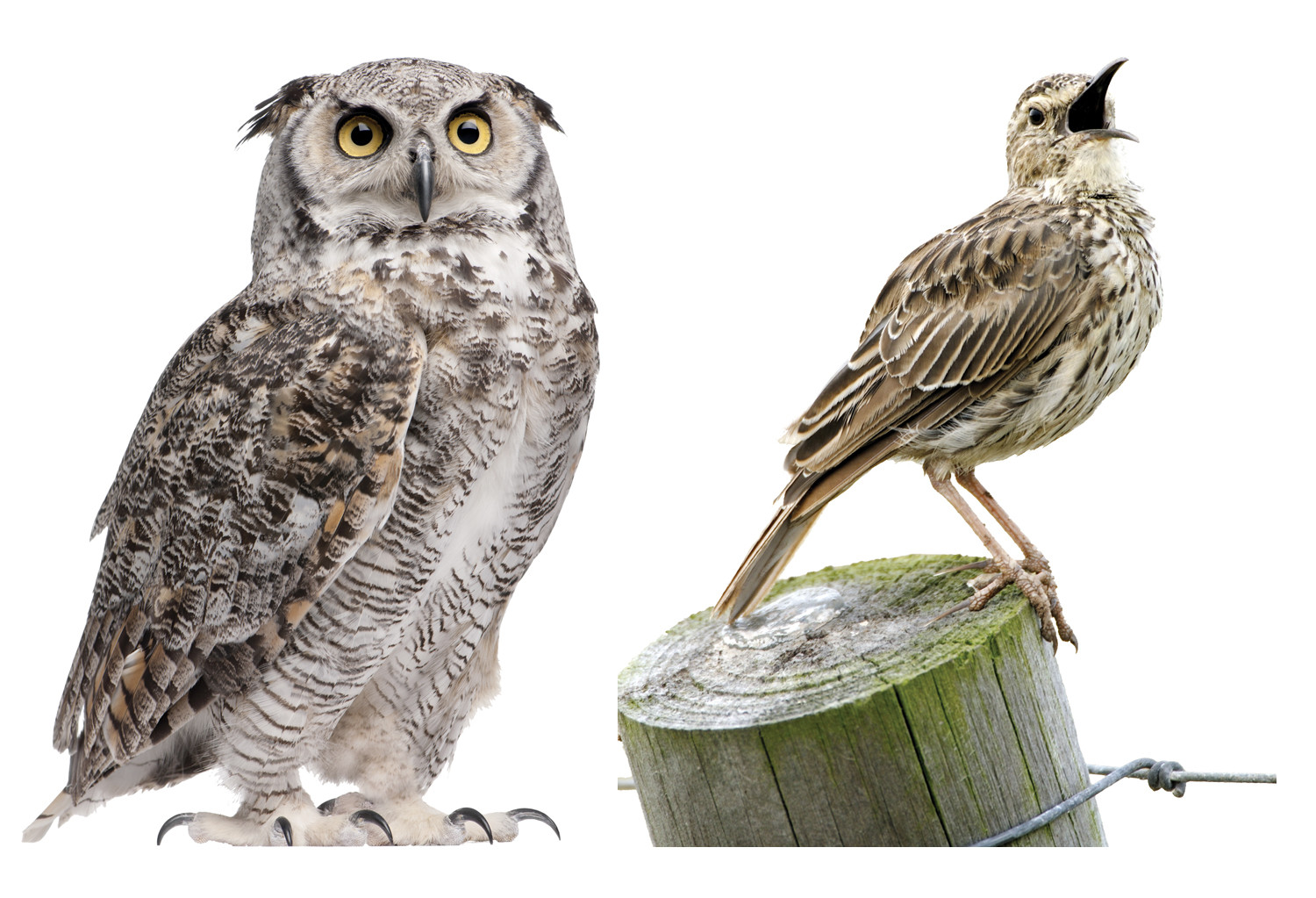
Peter Chadwick/Photo Researchers, Inc.
SLEEP STAGES Sooner or later, sleep overtakes us and consciousness fades as different parts of our brain’s cortex stop communicating (Massimini et al., 2005). But rather than emitting a constant dial tone, the sleeping brain has its own biological rhythm.
About every 90 minutes, we cycle through distinct sleep stages. This basic fact apparently was unknown until 8-year-old Armond Aserinsky went to bed one night in 1952. His father, Eugene, needed to test an electroencephalograph he had repaired that day (Aserinsky, 1988; Seligman & Yellen, 1987). Placing electrodes near Armond’s eyes to record the rolling eye movements then believed to occur during sleep, Aserinsky watched the machine go wild, tracing deep zigzags on the graph paper. Could the machine still be broken? As the night proceeded and the activity recurred, Aserinsky realized that the periods of fast, jerky eye movements were accompanied by energetic brain activity. Awakened during one such episode, Armond reported having a dream. Aserinsky had discovered what we now know as REM sleep (rapid eye movement sleep).
Similar procedures used with thousands of volunteers showed the cycles were a normal part of sleep (Kleitman, 1960). To appreciate these studies, imagine yourself as a participant. As the hour grows late, you feel sleepy and get ready for bed. A researcher comes in and tapes electrodes to your scalp (to detect your brain waves), on your chin (to detect muscle tension), and just outside the corners of your eyes (to detect eye movements) (Figure 2.27). Other devices will record your heart rate, respiration rate, and genital arousal.
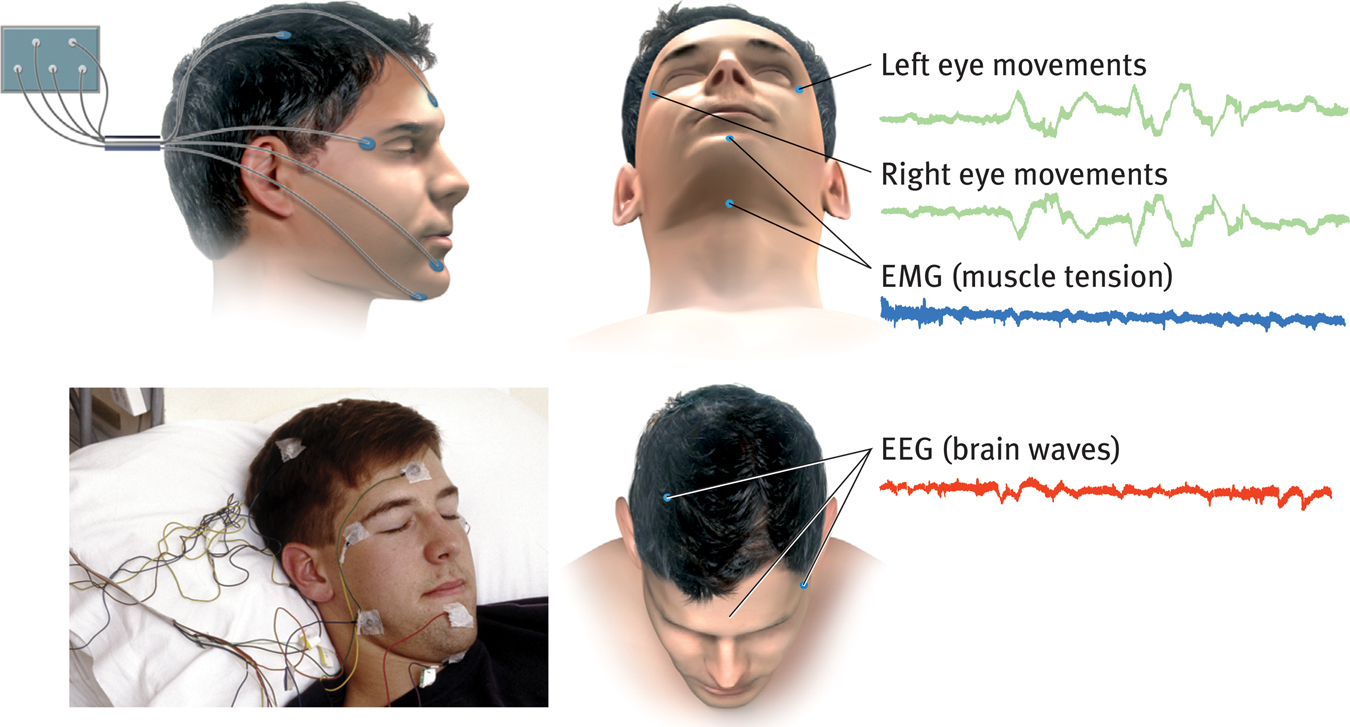
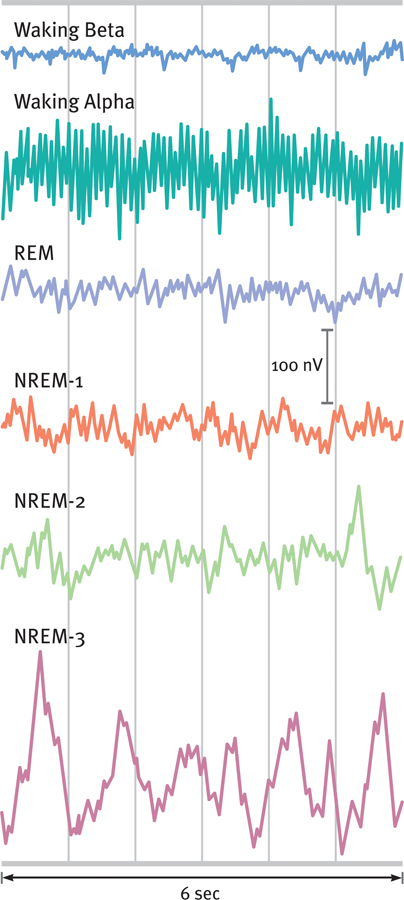
When you are in bed with your eyes closed, the researcher in the next room sees on the EEG the relatively slow alpha waves of your awake but relaxed state (Figure 2.28). As you adapt to all this equipment, you grow tired and, in a moment you won’t remember, you slip into sleep. The transition is marked by the slowed breathing and the irregular brain waves of non-REM stage 1 sleep. In the new American Academy of Sleep Medicine classification of sleep stages, this stage is called NREM-1 sleep (Silber et al., 2008).
54
During this brief NREM-1 sleep you may experience fantastic images resembling hallucinations. You may have a sensation of falling (at which moment your body may suddenly jerk) or of floating weightlessly. These hypnagogic sensations may later be incorporated into your memories. (“Hypnagogic” comes from the Greek root words meaning “leading to sleep.”) People who claim to have been abducted by aliens—often shortly after getting into bed—commonly recall being floated off (or pinned down on) their beds (Clancy, 2005).
You then relax more deeply and begin about 20 minutes of NREM-2 sleep, with its bursts of rapid, rhythmic brain-wave activity (see Figure 2.28). Although you could still be awakened without too much difficulty, you are now clearly asleep.
Then you enter the deep sleep of NREM-3. During this slow-wave sleep, which lasts for about 30 minutes, your brain emits large, slow delta waves. You would be hard to awaken. (It is at the end of the deep, slow-wave NREM-3 sleep that children may wet the bed.)
REM SLEEP About an hour after you first dive into sleep, a strange thing happens. You reverse course. From NREM-3, then back through NREM-2 (where you spend about half your night), you enter the most puzzling sleep phase—REM sleep (Figure 2.29). And the show begins. For about 10 minutes, your brain waves become rapid and saw-toothed, more like those of the nearly awake NREM-1 sleep. But unlike NREM-1, during REM sleep your heart rate rises and your breathing becomes rapid and irregular. Every half-minute or so, your eyes dart around in a brief burst of activity behind closed lids. These eye movements announce the beginning of a dream—often emotional, usually story-like, and richly hallucinatory.

Except during very scary dreams, your genitals become aroused during REM sleep. You have an erection or increased vaginal lubrication and clitoral engorgement, regardless of whether the dream’s content is sexual (Karacan et al., 1966). Men’s common “morning erection” stems from the night’s last REM period, often just before waking. (Many men troubled by erectile disorder [impotence] still have sleep-related erections, suggesting the problem is not between their legs.)
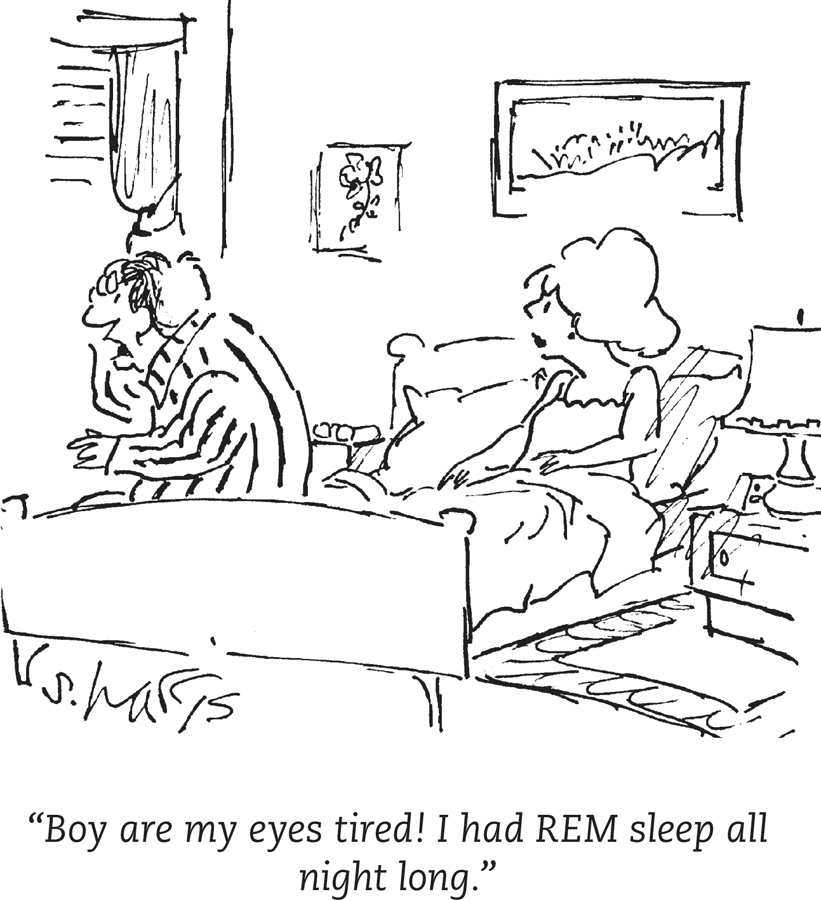
Your brain’s motor cortex is active during REM sleep, but your brainstem blocks its messages. This leaves your muscles relaxed, so much so that, except for an occasional finger, toe, or facial twitch, you are essentially paralyzed. Moreover, you cannot easily be awakened. REM sleep is thus sometimes called paradoxical sleep: The body is internally aroused and externally calm—except for those darting eyes.

55
The sleep cycle repeats itself about every 90 minutes for younger adults (somewhat more often for older adults). As the night wears on, deep NREM-3 sleep grows shorter and disappears. REM and NREM-2 sleep periods get longer (see Figure 2.29). By morning, we have spent 20 to 25 percent of an average night’s sleep—some 100 minutes—in REM sleep. Thirty-seven percent of people have reported rarely or never having dreams “that you can remember the next morning” (Moore, 2004). Yet even they, more than 80 percent of the time, will recall a dream if awakened during REM sleep. Each year, we spend about 600 hours experiencing some 1500 dreams. Over a typical lifetime, this adds up to more than 100,000 dreams—all swallowed by the night but not acted out, thanks to REM’s protective paralysis. 
RETRIEVE + REMEMBER
Question 2.20
Why would communal sleeping provide added protection for these soldiers?
With each soldier cycling through the sleep stages independently, it is very likely that at any given time at least one of them will be awake or easily wakened in the event of a threat.
Question 2.21
What are the four sleep stages, and in what order do we normally travel through those stages?
REM, NREM-1, NREM-2, NREM-3; normally we move through NREM-1, then NREM-2, then NREM-3, then back up through NREM-2 before we experience REM sleep.
Question 2.22
Can you match the cognitive experience with the sleep stage?
| Type | Description |
|
|
1. b, 2. c, 3. a
Why Do We Sleep?
2-16 How do our sleep patterns differ? What five theories describe our need to sleep?
Horses, which spend 92 percent of each day standing and can sleep standing, must lie down for muscle-paralyzing REM sleep (Morrison, 2003).
The idea that “everyone needs 8 hours of sleep” is untrue. Newborns often sleep two-thirds of their day, most adults no more than one-third. Still, there is more to our sleep differences than age. Some of us thrive with fewer than 6 hours a night. Others regularly rack up 9 hours or more (Coren, 1996). Heredity influences sleep patterns (Hor & Tafti, 2009). In studies of fraternal and identical twins, only the identical twins had strikingly similar patterns (Webb & Campbell, 1983).
2004 Gallup poll:
“Usually, how many hours of sleep do you get at night?”
5 or less 24%
2004 average = 6.8 hours
1942 average = 7.6 hours
But we should not overstress biology. Remember another of this book’s themes: Individual and social-cultural forces also affect behavior. Sleep patterns are culturally influenced. In industrialized nations, people now sleep less than they did a century ago. Thanks to modern lighting, shift work, and social diversions, those who would have gone to bed at 9:00 p.m. are now up until 11:00 p.m. or later.
Bright light at night can disrupt our biological clock, tricking the brain into thinking it’s morning. The process begins in the retinas in our eyes, which contain light-sensitive proteins. Normally, morning light sets off an internal alarm by activating these proteins, which then signal neural clusters in the brain (Foster, 2004). The brain interprets these signals as orders to decrease production of the sleep-inducing hormone melatonin. In sleep as in waking behavior, environment and biology interact.
SLEEP THEORIES So our sleep patterns differ from person to person and from culture to culture. But why do we need to sleep? Psychologists offer five possible reasons why sleep evolved.
56
- Sleep protects. When darkness shut down the day’s hunting, food gathering, and travel, our distant ancestors were better off asleep in a cave, out of harm’s way. Those who didn’t try to navigate around rocks and cliffs at night were more likely to leave descendants. This fits a broader principle: A species’ sleep patterns tend to suit its place in nature. Animals with the greatest need to graze and the least ability to hide tend to sleep less (see Figure 2.30).
 FIGURE 2.30 Animal sleep times Would you rather be a brown bat and sleep 20 hours a day or a giraffe and sleep 2 hours (data from NIH, 2010)?Kruglov_Orda/Shutterstock; Courtesy of Andrew D. Myers; © Anna63/Dreamstime.com; Steffen Foerster Photography/Shutterstock; The Agency Collection/Punchstock; Eric Isselée/Shutterstock; pandapaw/Shutterstock.
FIGURE 2.30 Animal sleep times Would you rather be a brown bat and sleep 20 hours a day or a giraffe and sleep 2 hours (data from NIH, 2010)?Kruglov_Orda/Shutterstock; Courtesy of Andrew D. Myers; © Anna63/Dreamstime.com; Steffen Foerster Photography/Shutterstock; The Agency Collection/Punchstock; Eric Isselée/Shutterstock; pandapaw/Shutterstock.One study of a decade’s 24,121 Major League Baseball games found a circadian disadvantage. Teams that had crossed three time zones before playing a multiday series had nearly a 60 percent chance of losing their first game (Winter et al., 2009).
- Sleep helps us recover. Sleep helps restore and repair brain tissue. Bats and many other small animals burn a lot of calories, producing a lot of free radicals, molecules that are toxic to neurons. Sleeping a lot gives resting neurons time to repair and reorganize themselves (Gilestro et al., 2009; Siegel, 2003). Think of it this way: When consciousness leaves your house, brain construction workers come in for a makeover.
- Sleep helps us remember. During sleep, we restore and rebuild our memories of the day’s experiences. People trained to perform tasks recall them better after a night’s sleep, or even after a short nap, than after several hours awake (Stickgold & Ellenbogen, 2008). Sleep strengthens neural memory traces and makes them more stable (Racsmány et al., 2010; Rasch & Born, 2008). After sleeping well, older people remember more. And the neural activity that takes place during slow-wave sleep seems to let humans (and rats) relive earlier experiences, and to remember them better (Peigneux et al., 2004; Ribeiro et al., 2004). Sleep, it seems, strengthens memories in a way that being awake does not.
- Sleep feeds creative thinking. A full night’s sleep boosts our thinking and learning. After working on a task, then sleeping on it, people solve problems more insightfully than do those who stay awake (Wagner et al., 2004). They also are better at spotting connections among novel pieces of information (Ellenbogen et al., 2007). To think smart and see connections, it often pays to sleep on it.
“Sleep faster, we need the pillows.”
Yiddish proverb
- Sleep supports growth. During deep sleep, the pituitary gland releases a hormone we need for muscle development. A regular full night’s sleep can “dramatically improve your athletic ability” (Maas & Robbins, 2010). Well-rested athletes have faster reaction times, more energy, and greater endurance. Teams that build 8 to 10 hours of daily sleep into their training show improved performance.
Given all the benefits of sleep, it’s no wonder that sleep loss hits us so hard.
RETRIEVE + REMEMBER
Question 2.23
What five theories explain our need for sleep?
(1) Sleep has survival value. (2) Sleep helps restore and repair brain tissue. (3) During sleep we strengthen memory traces. (4) Sleep fuels creativity.(5) Sleep plays a role in the growth process.
Sleep Deprivation and Sleep Disorders
2-17 How does sleep loss affect us, and what are the major sleep disorders?
Sleep commands roughly one-third of our lives—some 25 years, on average. When our body yearns for sleep but does not get it, we feel terrible. Trying to stay awake, we will eventually lose. In the tiredness battle, sleep always wins.
THE EFFECTS OF SLEEP LOSS Today, more than ever, our sleep patterns leave us not only sleepy but drained of energy and feelings of well-being. After a series of 5-hour nights, we run up a sleep debt that can’t be repaid with one long sleep. “The brain keeps an accurate count of sleep debt for at least two weeks,” reported sleep researcher William Dement (1999, p. 64).
With enough sleep, we awake refreshed and in a better mood. We work more efficiently and accurately. College and university students are especially sleep deprived. In one national survey, 69 percent reported “feeling tired” or “having little energy” on several or more days in the last two weeks (AP, 2009). Small wonder so many fall asleep in class. When the going gets boring, the students start snoring. Even when awake, they often function below their peak.
57
Sleep deprivation slows reactions and increases errors on some visual attention tasks (Lim & Dinges, 2010). When sleepy frontal lobes confront an unexpected situation, slow responses can spell disaster. Driver fatigue has contributed to an estimated 20 percent of American traffic accidents (Brody, 2002). One two-year study examined the driving accident rates of more than 20,000 Virginia 16- to 18-year-olds in two major cities. In one city, the high schools started 75 to 80 minutes later than in the other. The late starters had about 25 percent fewer crashes (Vorona et al., 2011).
Twice each year, most Americans participate in a sleep-manipulation experiment—the “spring forward” to daylight savings time and “fall backward” to standard time. A search of millions of records showed that in both Canada and the United States, accidents increased immediately after the time change that shortened sleep (Figure 2.31). The bottom line: Less sleep can mean more accidents.
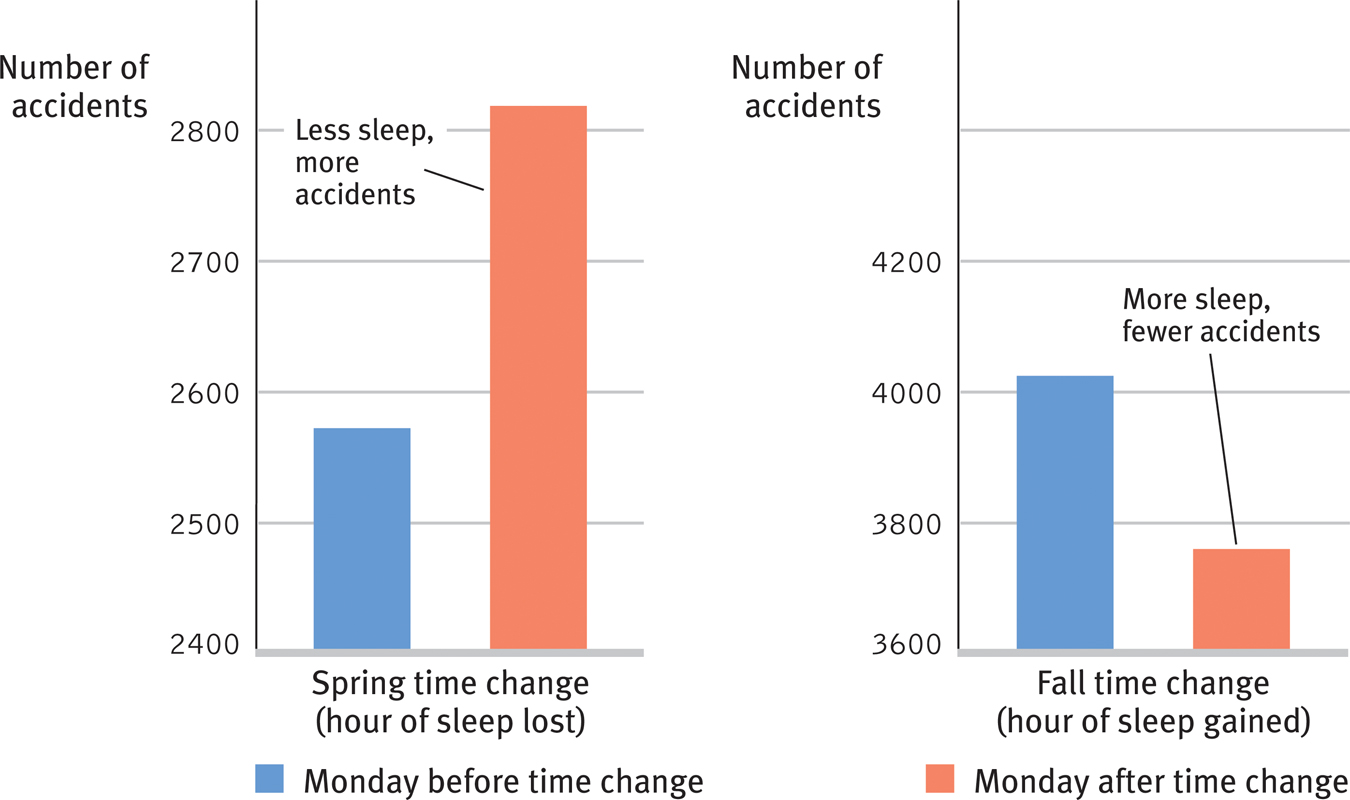
When tired, the trouble people have concentrating leads to more “cyberloafing”—frittering away time online. On the Monday after daylight savings time begins, entertainment-related Google searches have been 3.1 percent higher than on the preceding Monday, and 6.4 higher than on the following Monday (Wagner, 2012). In another study, researchers had students wear a sleep-monitoring bracelet overnight. Those who were sleep deprived spent more time cyberloafing during a 42-minute video lecture.

Another effect of chronic sleep loss is immune system suppression. With sleep deprivation, we produce fewer immune cells, which battle viral infections and cancer (Beardsley, 1996; Irwin et al., 1994). One experiment exposed volunteers to a cold virus. Those who had been averaging less than 7 hours of sleep a night were three times more likely to develop the cold than were those sleeping 8 or more hours a night (Cohen et al., 2009).
Sleep loss can also predict depression. In a study of 15,500 young people (12 to 18 years old) the risk of depression among those who slept 5 or fewer hours a night was 71 percent higher than among others who slept 8 hours or more (Gangwisch et al., 2010). Studies of nearly 70,000 adults have revealed a doubled risk of future depression among people with ongoing problems going to sleep or staying asleep (Baglioni et al., 2011). REM sleep’s processing of emotional experiences helps protect against depression (Walker & van der Helm, 2009). After a good night’s sleep, we often feel better the next day.
58
Some students have a sleep schedule like that of the fellow who stayed up all night to see where the Sun went. (Then it dawned on him.)
Can lack of sleep make you gain weight? Yes, by increasing ghrelin, a hunger-arousing hormone, and decreasing its hunger-suppressing partner, leptin. Sleep deprivation also increases cortisol, a stress hormone that triggers fat production. Sure enough, children and adults who sleep less than normal are fatter than those who sleep more (Chen et al., 2008; Knutson et al., 2007; Schoenborn & Adams, 2008). And in experiments, adults deprived of sleep had increased appetites and ate more (Nixon et al., 2008; Patel et al., 2006; Spiegel et al., 2004; Van Cauter et al., 2007). This may help explain the common weight gain among sleep-deprived college students.
Figure 2.32 summarizes these and other effects of sleep deprivation. But there is good news! Psychologists have discovered a treatment that strengthens memory, increases concentration, boosts mood, moderates hunger and obesity, fortifies the disease-fighting immune system, and lessens the risk of fatal accidents. Even better news: The treatment feels good, it can be self-administered, the supplies are limitless, and it’s free! If you are a typical college-age student, often going to bed near 2:00 a.m. and dragged out of bed 6 hours later by the dreaded alarm, the treatment is simple: Each night just add an hour to your sleep.
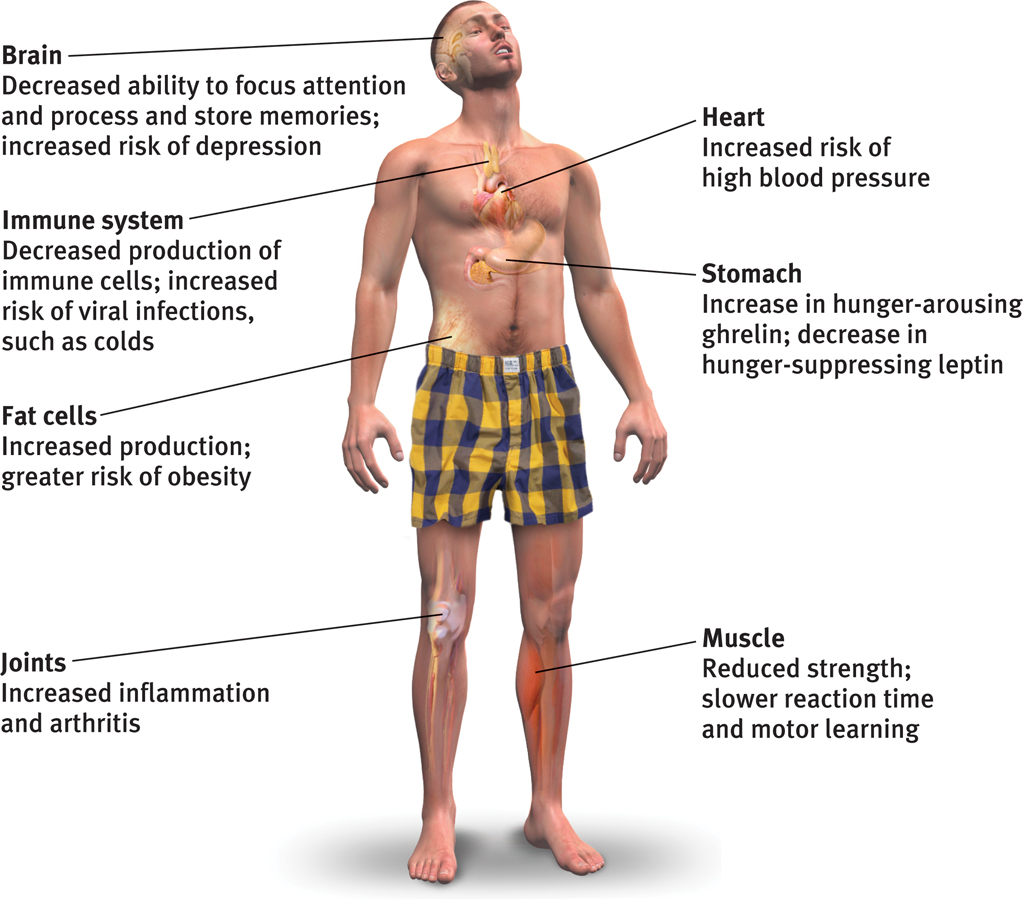
“Sleep is like love or happiness. If you pursue it too ardently it will elude you.”
Wilse Webb (1992)
MAJOR SLEEP DISORDERS To manage your life with enough sleep to awaken naturally and well rested is to be more alert, productive, happy, healthy, and safe. But for many people, that goal is hard to achieve. The major sleep disorders include insomnia; narcolepsy; sleep apnea; and sleepwalking, sleeptalking, and night terrors.
No matter what their normal need for sleep, some 1 in 10 adults, and 1 in 4 older adults, complain of insomnia. These people have ongoing problems in falling or staying asleep, not just an occasional loss of sleep when anxious or excited.
Many who complain of insomnia overestimate their actual sleep loss and underestimate their sleep time (Harvey & Tang, 2012). Many others with true insomnia turn to popular quick fixes, such as sleeping pills and alcohol. Far from “fixing” the problem, these substances can make things worse because they reduce REM sleep and leave the person with the next-day blahs. They can also lead to tolerance—a state in which increasing doses are needed to produce an effect. An ideal sleep aid would mimic the natural chemicals abundant during sleep, reliably producing sound sleep without side effects. Until scientists can supply this magic pill, experts have offered some tips for getting better quality sleep (TABLE 2.2).
Falling asleep is not the problem for people with narcolepsy (from narco, “numbness,” and lepsy, “seizure”), who have sudden attacks of overwhelming sleepiness, usually lasting less than 5 minutes. Narcolepsy attacks can occur at the worst times, perhaps just after taking a terrific swing at a softball or when laughing loudly, shouting angrily, or having sex (Dement, 1978, 1999). In severe cases, the person collapses directly into a brief period of REM sleep, with loss of muscle control. People with narcolepsy—1 in 2000 of us, estimated the Stanford University Center for Narcolepsy (2002)—must therefore live with extra caution. As a traffic menace, “snoozing is second only to boozing,” said the American Sleep Disorders Association, and those with narcolepsy are especially at risk (Aldrich, 1989).
59

Sleep apnea also puts millions of people—1 in 20 of us—at increased risk of traffic accidents (Teran-Santos et al., 1999). Apnea means “with no breath,” and during sleep, people with this condition stop breathing over and over again. After an airless minute or so, their blood oxygen drops enough to jolt them awake, and they snort in air for a few seconds. This happens hundreds of times each night, depriving these people of slow-wave sleep and leaving them feeling fatigued and depressed the next day. Because they don’t recall these episodes the next day, many apnea sufferers are unaware of their disorder (Peppard et al., 2006).
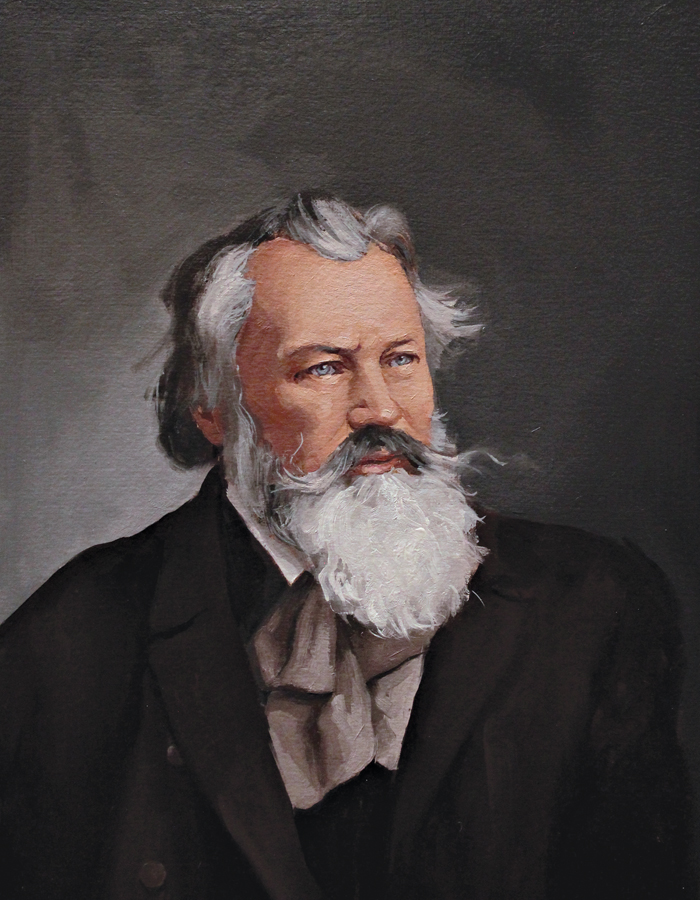
Sleep apnea is linked with obesity, particularly among overweight men, including some football players (Keller, 2007). In addition to loud snoring, other warning signs are daytime sleepiness, irritability, and (possibly) high blood pressure (Dement, 1999). If one doesn’t mind looking a little goofy in the dark, the treatment—a masklike device with an air pump that keeps the sleeper’s airway open (imagine a snorkeler at a slumber party)—can effectively relieve apnea symptoms.
Sleepwalking and sleeptalking are usually childhood disorders, and they run in families. If a fraternal twin sleepwalks, the odds are about 1 in 3 that the other twin will also sleepwalk. But if twins are genetically identical, the odds increase to 1 in 2. The same is true for sleeptalking (Hublin et al., 1997, 1998). Sleepwalking is usually harmless. After returning to bed on their own or with the help of a family member, few sleepwalkers recall their trip the next morning.
Sleepwalking happens during NREM-3 sleep. So do night terrors, which are not nightmares. During an attack, a child may sit up or walk around, talk nonsense, and appear terrified. The child’s heart and breathing rates may double. Luckily, children remember little or nothing of the fearful event the next day (Hartmann, 1981). Children have the deepest and longest NREM-3 sleep, so it’s no surprise that they most often have night terrors and sleepwalk. As deep NREM-3 sleep decreases with age, these disorders become more and more rare.
60
Dreams
2-18 What do we dream about, and what are five theories of why we dream?
Our two-track mind is clearly at work during sleep. Consider all the events happening outside our waking conscious awareness. We may stop breathing (sleep apnea), stroll around (sleepwalking), talk to imaginary people (sleeptalking), or dream.
Each of us spends about six years of our life in dreams—adventures that remain locked behind our moving eyelids and usually vanish with the new day. The discovery of the link between REM sleep and dreaming gave us a key to that lock. Now, instead of relying on a dreamer’s hazy recall hours or days after waking, researchers can catch dreams as they happen. They can awaken people during or within 3 minutes after a REM sleep period and hear a vivid account.
WHAT WE DREAM REM dreams—the sleeping mind’s hallucinations—are vivid, emotional, and often bizarre (Loftus & Ketcham, 1994). Unlike daydreams, the dreams of REM sleep are so vivid we may confuse them with reality. Awakening from a nightmare, a 4-year-old may scream in fear of the bear in the house.
A popular sleep myth: If you dream you are falling and hit the ground (or if you dream of dying), you die. Unfortunately, those who could confirm these ideas are not around to do so. Many people, however, have had such dreams and are alive to report them.
Few dreams are sweet. For both women and men, 8 in 10 dreams are bad dreams (Domhoff, 2007). Common themes are failing in an attempt to do something; being attacked, pursued, or rejected; or experiencing misfortune (Hall et al., 1982). Dreams with sexual imagery occur less often than you might think. In one study, only 1 in 10 dreams among young men and 1 in 30 among young women had sexual overtones (Domhoff, 1996). More commonly, our dreams feature people and places from the day’s nonsexual experiences (De Koninck, 2000).
Our two-track mind is monitoring our environment even while we sleep. Sensory stimuli—a particular odor or a phone’s ringing—may be instantly woven into a dream story. In a classic experiment, researchers lightly sprayed cold water on dreamers’ faces (Dement & Wolpert, 1958). Compared with sleepers who did not get the cold-water treatment, these people were more likely to dream about a waterfall, a leaky roof, or even about being sprayed by someone.
WHY WE DREAM Dream theorists have proposed several explanations of why we dream, including these five:
- To satisfy our own wishes. In 1900, Sigmund Freud offered what he thought was “the most valuable of all the discoveries it has been my good fortune to make.” He proposed that dreams act as a safety valve, discharging feelings that cannot be expressed in public. He called the dream’s remembered story line its manifest content. For Freud, this apparent content was a censored, symbolic version of the dream’s underlying meaning—the latent content, or unconscious drives and wishes that would be threatening if expressed directly. Most dreams have no openly sexual imagery. Freud nevertheless believed that most adult dreams could be “traced back by analysis to erotic wishes.” Thus, a gun appearing in a dream could be a penis in disguise.
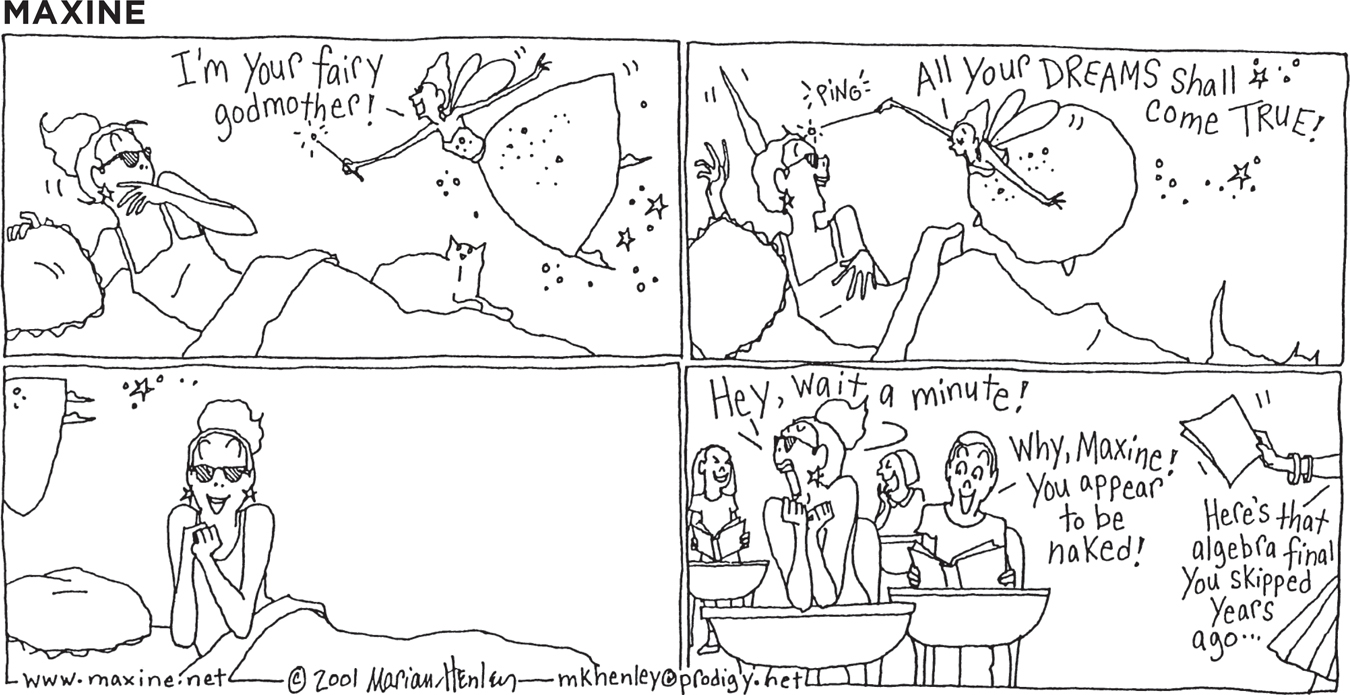 ©2001 Marian Henley
©2001 Marian Henley
Freud’s critics say it is time to wake up from Freud’s dream theory, which is a scientific nightmare. Scientific studies offer “no reason to believe any of Freud’s specific claims about dreams and their purposes,” said dream researcher William Domhoff (2000). Maybe a dream about a gun is really just a dream about a gun. Legend has it that even Freud, who loved to smoke cigars, agreed that “sometimes, a cigar is just a cigar.” Other critics have noted that dreams may be interpreted in many different ways. - To file away memories. The information-processing perspective proposes that dreams may help sift, sort, and fix the day’s events in our memory. Some studies support this view. When tested the day after learning a task, those who had slept undisturbed did better than those who had been deprived of both slow-wave and REM sleep (Stickgold et al., 2000, 2001).
Students, take note. Sleep researcher Robert Stickgold (2000) believes many students suffer from a kind of sleep bulimia, binge sleeping on the weekend. The weekday sleep deprivation leaves not enough time for memory consolidation (the sleep-aided processing and storing of memories). From Stickgold’s information-processing perspective he warns, “If you don’t get good sleep and enough sleep after you learn new stuff, you won’t integrate it effectively into your memories.” In one study, high-achieving secondary students with top grades averaged 25 minutes more sleep a night and went to bed 40 minutes earlier than their lower-achieving classmates (Wolfson & Carskadon, 1998).
Brain scans have confirmed the link between REM sleep and memory. Brain regions that were active as rats learned to navigate a maze (or as people learned to perform a visual-discrimination task) were active again later during REM sleep (Louie & Wilson, 2001; Maquet, 2001). So precise were these activity patterns that scientists could tell where in the maze the rat would be if awake. - To develop and preserve neural pathways. Dreams, or the brain activity linked to REM sleep, may give the sleeping brain a workout that helps it develop. As we’ll see in Chapter 3, stimulating experiences preserve and expand the brain’s neural pathways. Infants, whose neural networks are fast developing, spend much of their abundant sleep time in REM sleep.
- To make sense of neural static. Other theories propose that dreams are born when random neural activity spreads upward from the brainstem (Antrobus, 1991; Hobson, 2003, 2004, 2009). Our ever-alert brain attempts to make sense of the activity, pasting the random bits of information into a meaningful image, much as children construct storybooks from snippets of magazine photos.
- To reflect cognitive development. Some dream researchers see dreams as a reflection of brain maturation and cognitive development (Domhoff, 2010, 2011; Foulkes, 1999). For example, before age 9, children’s dreams seem more like a slide show and less like an active story in which the child is an actor. Dreams at all ages tend to feature the kind of thinking and talking we demonstrate when awake. They seem to draw on our current knowledge and concepts we understand.
TABLE 2.3 compares these major dream theories. There is one thing today’s dream researchers agree on: We need REM sleep. Deprived of it in sleep labs or in real life, people return more and more quickly to the REM stage when finally allowed to sleep undisturbed. They literally sleep like babies—with increased REM sleep, known as REM rebound. Withdrawing REM-suppressing sleeping pills also increases REM sleep, often with nightmares.
62
RETRIEVE + REMEMBER
Question 2.24
What five theories explain why we dream?
(1) Freud’s wish fulfillment (dreams as a psychic safety valve), (2) information processing (dreams sort the day’s events and form memories), (3) physiological function (dreams pave neural pathways), (4) neural activation (REM sleep triggers random neural activity that the mind weaves into stories), (5) cognitive development (dreams reflect the dreamer’s developmental stage)
We have glimpsed the truth of this chapter’s overriding principle: Everything psychological is simultaneously biological. You and I are privileged to live in a time when the pace of discoveries about the interplay of our biology and our behavior and mental processes is truly breathtaking. Yet what is unknown still dwarfs what is known. We can describe the brain. We can learn the functions of its parts. We can study how the parts communicate. We can observe sleeping and waking brains. But how do we get mind out of meat? How does the electrochemical whir in a hunk of tissue the size of a head of lettuce give rise to a feeling of joy, a creative idea, or a crazy dream?
The mind seeking to understand the brain—that is indeed among the ultimate scientific challenges. And so it will always be. To paraphrase scientist John Barrow, a brain simple enough to be understood is too simple to produce a mind able to understand it.

